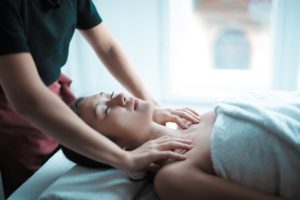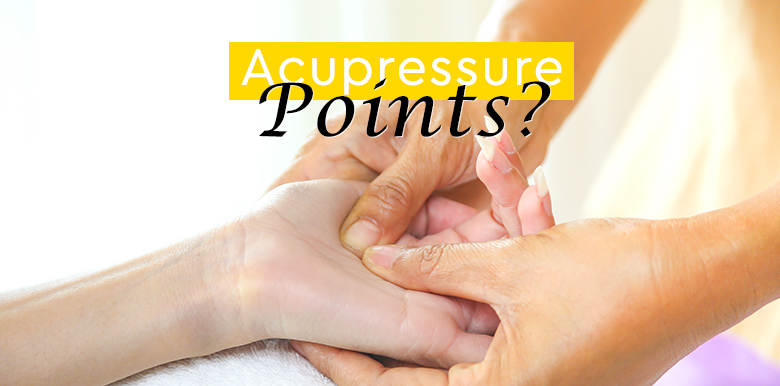What is acupressure?
Acupressure uses pressure points to address a variety of health conditions such as depression, menstrual pain, labor pain, or nausea from chemotherapy. It’s rooted in traditional Chinese medicine and has been around for over 2,000 years.
It involves using fingers, palms, or elbows to place physical pressure on classic acupuncture points found throughout the body.

Acupressure
How does acupressure work?
Acupressure points are located next to the largest nerve fiber pathways in your body that carry messages from nerve endings through your central nervous system. When they’re pressed the right way, two things can happen:
Messages of pain can be blocked before they reach the brain
Other messages can be sent to the brain telling it to release endorphins – chemicals that reduce pain and restore a sense of well-being
The best way to think about acupressure for self-care is to understand it’s not an on-off switch that makes pain or discomfort go away immediately. Instead it’s more like the opening and closing of gates.
Applying acupressure to certain points on the body can close off or block nerve impulses that transmit pain to the brain. Simultaneously, it can open up communication to the brain telling it to release pain-reducing chemicals into the bloodstream. Together, this opening and closing combination can allow a sense of wellbeing to flow through you.
What can acupressure help?
There are experts who know acupressure points that work on a wide variety of problems. But there are three points that can help relieve pain almost every person experiences: headaches, stomach aches or nausea, and body pain.
Where are acupressure points are located?
1. Acupressure Points for Arm Pain and Digestion
Pool at the Crook (Li 11): As its name suggests, this point is in the crook of the elbow. Hold your left arm in front of you at a 90-degree angle, as if it was in a sling. Turn the left palm up. Place your right thumb at the outside end of the elbow crease. Press firmly. Switch arms.
2. Acupressure Points for Headache, Muscles, and Bowel Movements
Adjoining Valley (Li 4): Position your left hand palm down and lightly squeeze your thumb and fingers together. A fleshy mound pops up in the webbing between the base of the index finger and thumb. Eyeball this spot, relax your left hand, and using your right hand (thumb above, index finger below), press on this point.
3. Acupressure Points for Energy
Three Mile Foot (St 36): This point is four finger widths below the lower edge of the kneecap and one finger width to the outside of the shinbone. You’ll know you’ve got it if, when you flex your foot, the leg muscle (the tibialis anterior) moves under your fingers.
4. Acupressure Points for Sinus Congestion
Abundant Splendor (St 40): A bit hard to find, this point is worth the hunt. It lies on the outside of the leg, halfway between the anklebone and the center of the kneecap. Take a seat. Wrap your fingers around the back of the shin at the middle of the leg. Using your thumb, press into the shinbone (tibia), and then slide your thumb two inches or so off the bone toward the outside of the leg. Press firmly
5. Acupressure Points for Kidney Health
Supreme Stream (Kd 3): Find this point by putting your right thumb on the inside of the prominent bone in the left ankle. Next, let your thumb slide toward the Achilles’ tendon. The point is in the depression between the bone and the tendon.
6. Acupressure Points for Menstrual Cramps
Three Yin Meeting (Sp 6): The three meridians of the leg cross at this point on the inside of the leg above the anklebone. To find it, press your thumb into the center of your anklebone, then slide up the inner leg four finger widths. The point is just off the shinbone (tibia), toward the back of the leg.
7. Acupressure Points for Skin Problems
Sea of Blood (Sp 10): To find these two points, sit in a chair with your feet flat on the floor. Feel for a bulge in your thigh muscles about two thumb widths above the top edge of your knee. The bulge is on the top inside portion of the leg. Press on the points firmly with your thumbs or the knuckle of your middle finger.
In order to receive the full benefit of an acupressure session, it is important to do some simple stretching and breathing exercises before each acupressure session.
